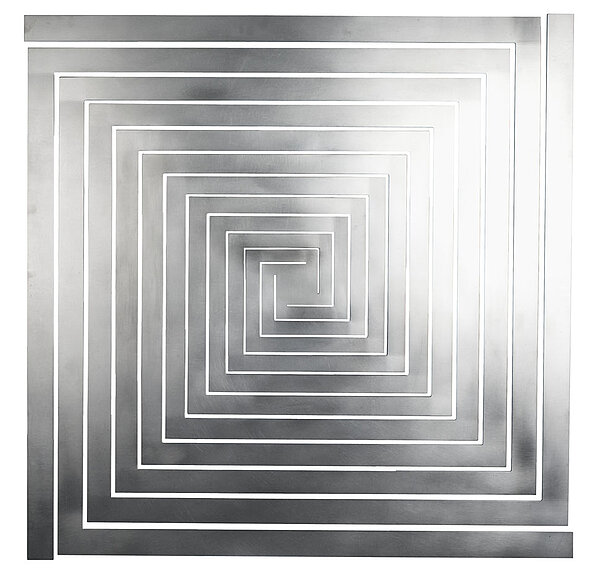Martin Willing
Bewegtes Quadrat, 2011
[Animated Square]
Titanium, waterjet cut, chamfered, pre-stressed
97 x 97 x 15 cm
© VG Bild-Kunst, Bonn 2025
Photo: Gerhard Sauer
Since the late seventies, Martin Willing has devoted his attention with his metal sculptures to the phenomenon of motion. But unlike the works of other Kineticists from the past, such as Alexander Calder, George Rickey or Jean Tinguely, the motion in Willing’s works does not come about from the use of hinges, armatures or motors. The artist sounds out, rather, the inherent potential for movement in the metals he uses, which is set going by an initial external impulse. He is concerned with lending visibility to the specific slow vibratory behaviour that can arise from the interaction between the material, the shape, and the way it is machined. Willing always develops his sculptures on the basis of observations and experiments, as well as his own exact calculations and simulations. He employs elastic metals that have high dimensional stability and low weight, as for instance spring steel, Duraluminium, Weldural or titanium. Pre-stressed, coiled, layered, curved, cut or welded – Willing uses the metal to create sculptures that are mostly based on simple geometrical forms and which oscillate in different ways, according to their specifically configured shapes. Willing’s early objects distinguish themselves by a simple grammar of forms. These are filigree pieces such as rods made of spring steel, which – pre-stressed so as to counter gravity – reach out into space as seemingly weightless lines with an almost graphic quality. The works made during his subsequent period are more complexly shaped spatial bodies that have at times entered public space in the form of monumental works.
Willing has created Bewegtes Quadrat [Animated Square] from a pre-stressed titanium panel. Commencing at the same distance from all four corners, he executed precise linear incisions parallel to the edges of the square, describing ninety degree turns at the imaginary diagonal axes and moving ever onward towards the centre until the originally flat panel was transformed into a wobbly configuration of increasingly narrow strips. These strips converge on the centre of the piece and on a small square which serves to attach the work by its rear face to the wall. While the spiraliform lineation already suggests a certain sense of depth, the piece’s overall funnel shape literally thrusts the work out into the surrounding space. Set in motion by a gentle push, the work begins rhythmically to vibrate: gliding waves spread out across the shimmering surface until the object gradually returns to rest. (Camilla Bonath-Völkel)
Martin Willing
1958 born in Bocholt (DE)
Lives and works in Cologne


